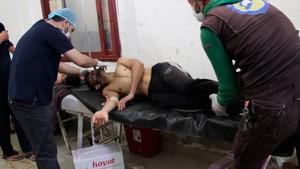Chemical weaponsMedical evidence confirms sarin gas was used in Syria chemical attack
Turkey’s health minister said that traces of sarin gas have been detected in blood and urine samples from victims injured in the town of Khan Sheikhun in Syria on 4 April, offering “concrete evidence” of its use in the attack. Isopropyl methylphosphonic acid, a chemical which sarin degrades into, was found in the blood and urine samples taken from the patients who arrived in Turkey. Many of the victims of last week’s attack were taken to Turkey for treatment because the Assad regime and Russia, as part of their war strategy, have destroyed many of the medical facilities in the Sunni areas of Syria.

Sarin gas victim receiving treatment // Source: theconversation.com
Turkey’s health minister said that traces of sarin gas have been detected in blood and urine samples from victims injured in the town of Khan Sheikhun in Syria on 4 April, offering “concrete evidence” of its use in the attack. Doctors and aid workers who had examined those who were injured in last week’s attack by the Syrian military, said the victims exhibited symptoms of exposure to a nerve agent similar to sarin, as well as a second chemical that may have been chlorine.
Many of the victims of last week’s attack were taken to Turkey for treatment because the Assad regime and Russia, as part of their war strategy, have destroyed many of the medical facilities in the Sunni areas of Syria. The BBC reports that the medical tests and autopsies in Turkey thus offer the first scientific information about the toxins used in the attack which killed more than eighty people.
The Turkish health minister Recep Akdağ said isopropyl methylphosphonic acid, a chemical which sarin degrades into, was found in the blood and urine samples taken from the patients who arrived in Turkey. Some thirty victims were brought across the border following the attack last Tuesday, and a number of them have died.
Turkish physicians, monitored by scientists from the World Health Organization (WHO), performed autopsies on the victims who died in Turkey shortly after the attack. The autopsies found evidence of exposure to sarin in each of the bodies on which autopsies were performed.
The BBC notes that results of the tests in Turkey will support the charges by Western powers that the Assad regime deployed sarin in violation of the 2013 U.S.-Russia agreement which stipulated that Syria would hand over all of its chemical weapons arsenal, and in violation of the Chemical Weapons Convention, which Syria joined in 2014.
Russia, Assad’s staunchest backer, has said the Syrian military’s air raids targeted a rebel warehouse which contained chemical weapons – and that these chemicals then leaked out to the surrounding area.
Military analysts dismissed this claim. They note that in the event of chemical weapons being destroyed by powerful explosions in a depot or a warehouse, most of the chemicals are destroyed in the blast and consumed by the heat which follows. Some dispersal of chemicals may occur, but if it does, it covers only a small area adjacent to the depot.
The victims in the 4 April attack were hit over a large area, consistent not only with an aerial attack – but with a sophisticated attack at that: the bombs carrying the chemicals had pressure or timer mechanisms to trigger an explosion at a pre-determined altitude to ensure the broadest and most effective dispersal of the toxic chemicals.
Chemical agents are quick to vaporize and they tend dissipate quickly, so the military personnel preparing the chemical weapons for use must determine at what altitude the bombs should explode. The determination is based on weather information, especially wind patterns and the amount of moisture in the air at the site of the targeted area.
The Guardian reports that a visit by its journalists to the site of the chemical attack found no evidence to back the Russian claim. The site which the Russians claimed was the rebels’ chemical weapons storage facility was found to be empty, abandoned warehouse and grain silos which were empty except for soil and animal feed.
There was also no sign that the site was ever bombed.
